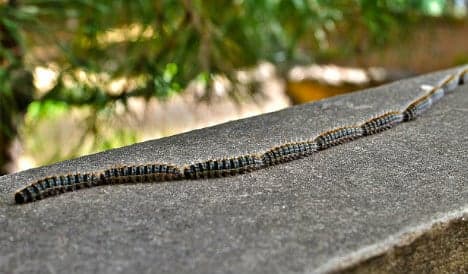Beware: toxic caterpillar plague arrives early in Spain

Dog walkers need to be particularly vigilant for a tiny but deadly creature that could kill your pet.
As winter thaws comes the threat of the Pine Processionary Caterpillar (Thaumetopoea Pityocampa).
"They pose a major risk to children and adults causing dermatitis, eye damage and severe allergic reaction and in pets even death," Milagros Fernandez de Lezeta, director of Spain's Pest Control Association (ANECPLA), told The Local.
And this year, despite the recent spell of cold weather, they have already been spotted in areas across Spain from Mijas to Alicante to Madrid.
The eggs are laid in candyfloss-like nests in pine trees where they remain during the cold winter months.
As the temperature starts to rise with the approach of spring, the caterpillars hatch and drop to the ground to search for food.
They can easily be spotted moving head to tail in a procession to form the conspicuous snake-like lines for which they are named.
Preocupados por la plaga de nidos de procesionarias del monte Abantos https://t.co/lmmQzY4iNh
— Telemadrid (@telemadrid) January 20, 2018
The caterpillars, measuring between three and four centimeters in length, are particularly dangerous to young children who may be curious enough to touch them, and to dogs, who may attempt to eat them.
Each caterpillar is covered with tiny barbed hairs containing a protein called thaumetopoein.
Dogs are the main victims as when they come into contact with the caterpillars can pick up the hairs on their paws, which are then licked because of the irritation and the poison spreads to the mouth.
They could suffer breathing difficulties, vomiting or start foaming at the mouth and should be taken urgently to the nearest veterinary clinic for an immediate cortisone and antibiotic inhection.
Sometimes amputation of the tongue or nose is the only course of action and of they reach the throat can cause suffocation and result in death.
The risk is particularly high in pine forests but is not confined exclusively to them and can occur anywhere where pine trees grow, including city parks, private gardens and roadsides.
Many councils carry out spraying in muncipal parks to lessen the danger but they can't always be relied upon to eiminate the pest entirely.
So be vigilant!
Comments
See Also
As winter thaws comes the threat of the Pine Processionary Caterpillar (Thaumetopoea Pityocampa).
"They pose a major risk to children and adults causing dermatitis, eye damage and severe allergic reaction and in pets even death," Milagros Fernandez de Lezeta, director of Spain's Pest Control Association (ANECPLA), told The Local.
And this year, despite the recent spell of cold weather, they have already been spotted in areas across Spain from Mijas to Alicante to Madrid.
The eggs are laid in candyfloss-like nests in pine trees where they remain during the cold winter months.
As the temperature starts to rise with the approach of spring, the caterpillars hatch and drop to the ground to search for food.
They can easily be spotted moving head to tail in a procession to form the conspicuous snake-like lines for which they are named.
Preocupados por la plaga de nidos de procesionarias del monte Abantos https://t.co/lmmQzY4iNh
— Telemadrid (@telemadrid) January 20, 2018
The caterpillars, measuring between three and four centimeters in length, are particularly dangerous to young children who may be curious enough to touch them, and to dogs, who may attempt to eat them.
Each caterpillar is covered with tiny barbed hairs containing a protein called thaumetopoein.
Dogs are the main victims as when they come into contact with the caterpillars can pick up the hairs on their paws, which are then licked because of the irritation and the poison spreads to the mouth.
They could suffer breathing difficulties, vomiting or start foaming at the mouth and should be taken urgently to the nearest veterinary clinic for an immediate cortisone and antibiotic inhection.
Sometimes amputation of the tongue or nose is the only course of action and of they reach the throat can cause suffocation and result in death.
The risk is particularly high in pine forests but is not confined exclusively to them and can occur anywhere where pine trees grow, including city parks, private gardens and roadsides.
Many councils carry out spraying in muncipal parks to lessen the danger but they can't always be relied upon to eiminate the pest entirely.
So be vigilant!
Join the conversation in our comments section below. Share your own views and experience and if you have a question or suggestion for our journalists then email us at [email protected].
Please keep comments civil, constructive and on topic – and make sure to read our terms of use before getting involved.
Please log in here to leave a comment.